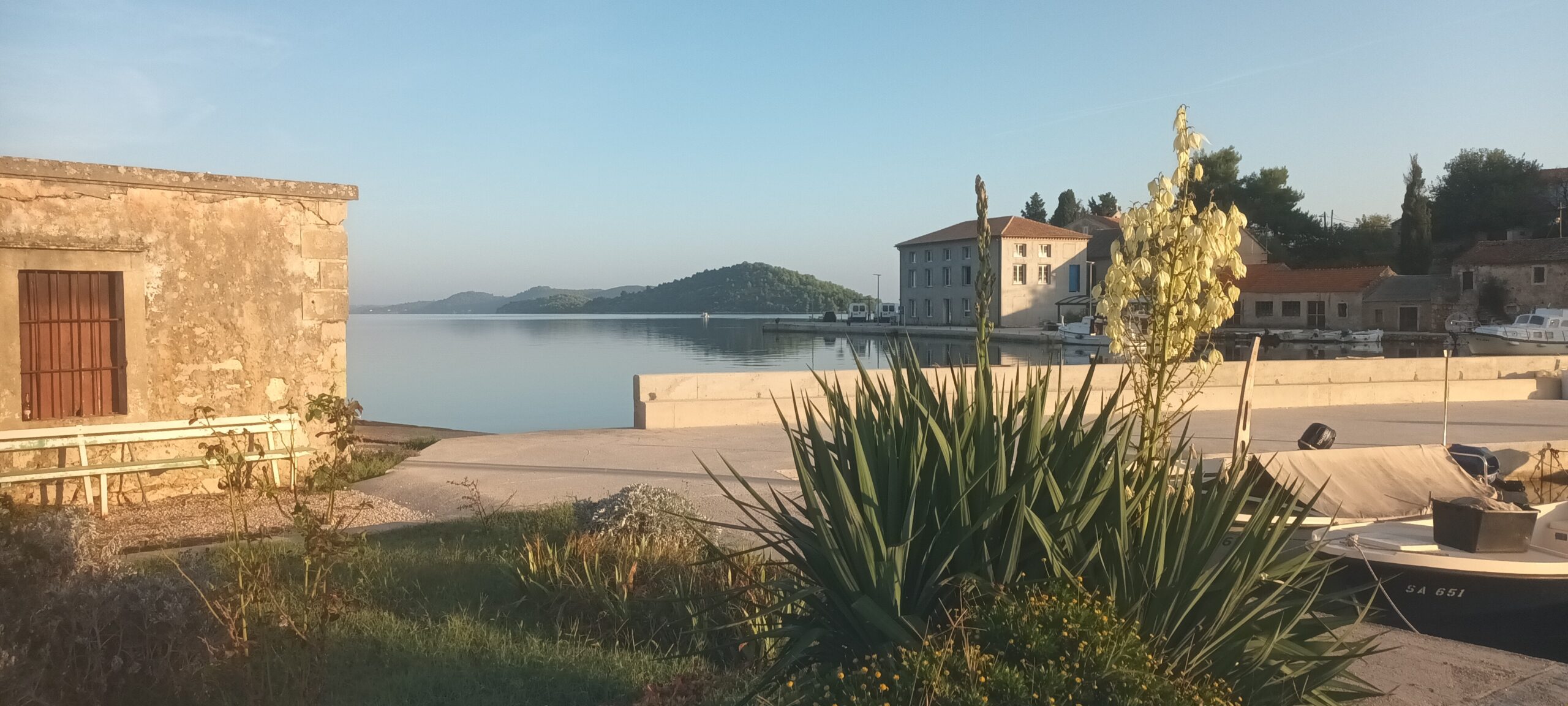Published in Guardian Travel
April 2024
The first thing that struck me about Luka was the silence.
My wife Caroline and I had driven our rental car from Split northwards up the Croatian coast to Zadar – stopping briefly on the way to be fleeced for homemade prosciutto and olive oil – and then taken an hour-and-a-half ferry ride to the island of Dugi Otok. Then we had driven the island’s length southwards, through pine forest and scrub, to arrive at this tiny fishing village, where we would spend the next week. Both of us were slightly wired from driving foreign roads. But the strange spell of Luka put an end to that.
Nothing moved, not even cats. Before us was a sheltered bay that seemed almost surreally smooth, undisturbed by the faintest breeze. Plaster flaked from the walls of crumbling fishing cottages, their gardens bright with flowering cactuses and bougainvillaea. A row of empty beer bottles outside the shuttered general store gave the deserted quay a Mary Celeste quality. Travelling in space can sometimes seem like travelling in time, and it felt as if we had stepped back to the 1950s.
Dugi Otok (‘Long Island’) is the westernmost of the Zadarian Islands off the Dalmatian Coast, and one of the least visited large islands in Croatia. Twenty-seven miles long and only three miles wide, the island’s slenderness makes it easy to explore, with a single road running from north to south. Its inhabitants – fewer than 1,500, many of whom leave in the winter months to escape the notorious Bora winds – are huddled on the eastern side, mostly in the ‘capital’ Sali, while the west falls away to steep cliffs and sand beaches. Cypress, pine, fig, olive and holm oak covers much of it, while the rest is blanketed in maquis, the scrubby evergreen underbrush of the Mediterranean. The plants comprising this dense weave are invariably spiked, hooked or barbed, as I learned the painful way going off piste from a walking trail; the next few days were spent nursing lacerated legs. The maquis makes the island wild in a way I hadn’t encountered before, as swathes of uncultivated land are impenetrable to humans.
We stayed in an old fishing cottage that had been in the owners’ family for years, tall and narrow, with strong stonewalls and a tiny balcony. Black and white photos gave an impression of their grandparents’ lives, fishing in the Adriatic through storms and bitter winters. The harbour was only steps away, and we befriended multiple cats in the restaurant on the quay: the Konoba Zlata Vala, which served carafes of local wine and one of best risottos we had ever tasted.
A short drive south from Luka is the Telašćica Nature Park, centred around one of the largest natural harbours in the Adriatic. On the western edge of a narrow bay that cuts inland for six miles, elevated above the sea by 500-foot-high cliffs, is the saline Lake Mir (‘Peace’), famed for its blue-green water. This is the island’s main tourist draw, as attested to by the yachts anchored in the bay below – snatches of boozy Italian and German drifted to us across the waves – but we spent most of the week seeking quieter corners. On Dugi Otok in September such a mission is not hard. The ‘only busy month’ is August, according to our guesthouse hosts, and often we would find ourselves on near-empty beaches.
Our favourite was Veli Žal, half a mile of pebbles and sand bordered by thick greenery, along which previous castaways had constructed driftwood shelters. A mysterious craftsperson had whittled windmills out of sticks that span rattling in the wind, the quirky generosity of which I found oddly moving. On afternoons when we didn’t feel like venturing far from home, the pebbly beach near Luka had its own scruffy charm. I was excited to meet a bright green praying mantis there, while the gloriously uninhibited elderly women sprawling naked on the rocks were a source of great admiration to Caroline. It reflected what we found to be an unbothered – and deeply relaxing – attitude among the islanders, and visitors, we encountered. Having said that, anti-nudity signs – a Ghostbusters-style bar across a cartoon pair of boobs – were displayed at Veli Rat, the lighthouse at the island’s northern tip. Islands are parochial. Things are different in the north.
Islands are also superstitious, refugiums of myth. At the sea-pool of Dragon’s Eye we found fossils in the rocks, memories of dinosaur times, and in the cave of Strašna peć – created by fairies in an attempt to split the island at its narrowest point – deep time was recorded in dripping stalactites. Like many Adriatic islands, for centuries on the frontline of invasion from the Ottomans, Dugi Otok also has its share of pirate stories. These coasts were once haunted by the Uskoks, Croatian sea-bandits used as proxy forces by the Hapsburg Empire, who wrought havoc on Venetian and Turkish fleets.
The best way to know islands, of course, is from the sea. On our penultimate day a skipper steered us in a boat southwards out of Sali, and through Telašćica Bay, into an archipelago that felt like another world. The Kornati National Park consists of 89 islands and islets scattered across eight miles south-east of Dugi Otok. They are starkly different to the forested place we’d just left, banded with karst rock formations like gigantic ammonites, yellow and desolate, looking – as our skipper said – ‘like Arabia or Iran’. A century ago, the Kornati Islands were purchased from the aristocrats of Zadar by peasant farmers for grazing sheep, which ate everything in sight. Most are uninhabited, apart from the hardiest souls; summers here are scorching and the winter winds are brutal. The isolation and wildness reflect an anti-authoritarian streak that goes back hundreds of years: when the ruling Austrians came to record the islands’ names, the locals gleefully told them that one was named Babina Guzica (‘Grandmother’s Arse’) and another Kurba Vela (‘Great Whore’). Happily, both those islands bear these names today.
As we returned to Dugi Otok, relieved by the sight of trees again, Caroline pointed out a sheep dozing on a headland. Our skipper said this matted beast was something of a celebrity, an escapee from a nearby island that had swum the narrow strait and successfully evaded recapture for ten years. Her pursuers have long since given up; the sheep has won her freedom. In November 2022, a stranded sheep in Scotland was ‘rescued’ and taken to a petting zoo, and was later used to front a rural loneliness campaign. In Dugi Otok, this proud loner is left to her own feral life, sunning herself beside some of the cleanest waters in the Mediterranean. The naked old ladies would approve. It perfectly encapsulates the spirit of the island.


